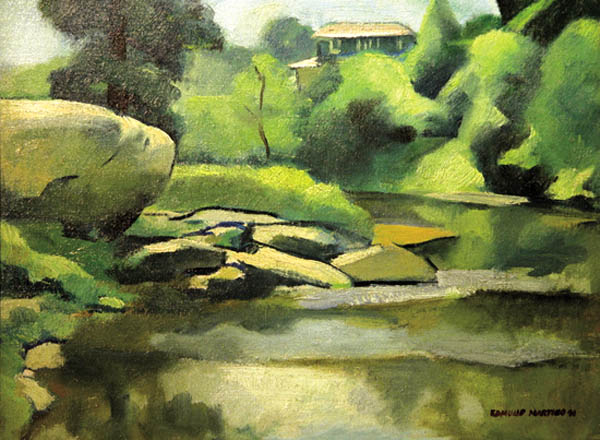The Art Legacy Of The Martino Family
The story starts with the hard working parents, Carmine and Clementina Martino, who emigrated to America from Italy in the late 1800s. Both had settled in South Philadelphia and they probably met at a local church dance. They married in 1895 and Clementina bore him nine children: seven boys and two girls, Filomena and Anntonetta. The seven brothers - Francesco, Antonio, Giovanni, Alberto, Ernesto, William and Edmund, all became artists.
Author James McClelland saw this family of dedicated artists as a story that needed to be told. He embarked on a three-year journey of research and interviews with the descendants, delving into the familys history and creative accomplishments. McClellands research revealed that this amazing family of artists was very much underrated and relatively unknown, yet, there are numerous art galleries today that champion their art, and their works are held in numerous art museums around the country. (See Side Bar for more about James McClellands new book, The Martinos: A Legacy Of Art.)
Carmine earned his living as a stonecutter, working on the Cathedral at Bryn Athyn, Pennsylvania, as well as the picturesque home of the wealthy Pitcairn family, also in Bryn Athyn. Clementinas artistry manifested itself in crocheted bedspreads, in needlework and tailoring all the clothes for her seven sons.
Francesco, called Frank, was born 1896 and died in 1941 of rheumatic fever. Dates for the other family members are: Antonio (Tony) Pietro (1902-1988); Albert (1904-1988); Ernesto (1906-1981); Giovanni (1908-1998); William (1910-1980) and Edmond (1915-2000); daughters: Filomena (1898-1922) and Antonetta (1900-1902).
Antonio displayed an interest in art, particularly sculpture, at an early age, perhaps from working on stone with his father in the basement of their South Philadelphia home, with hammer and chisel in hand. Antonio and Giovanni would become the most renowned in the family of painters.
When he was thirteen Tony began taking free art classes at the Graphic Sketch Club (Now the Fleisher Memorial) in South Philadelphia. It was there that his lifelong interest in drawing and two-dimensional art took root.
Ever thirsty to learn, by 1917, Tony was studying on weekends at the Spring Garden Institute and at the La France Art Institute, and attending evening classes at the Pennsylvania Museum School of Industrial Art (now the University of the Arts).
During this same period, young Antonio began working as a $3-a-week apprentice in the art department of Associated Artists, a local lithography firm.
Years later, in 1941, brothers Frank and Antonio founded Martino Studios at 27 South 18th Street. All of the brothers worked at the Studio, and there was a staff of twenty artists. The commercial studio produced advertising art for a number of national clients, including N.W. Ayer, Scott Paper Company; Philco Corporation; Bell Telephone, and E.I. du Pont de Nemours.
Having also attended the Pennsylvania Museum School, Frank inspired and taught his brothers, early on. Frank eventually became successful as an illustrator.
Tony started exhibiting his work at age seventeen. By 1925, he had won Honorable Mentions from The Art Club of Philadelphia and the Philadelphia Sketch Club. He also exhibited at The Pennsylvania Academy of the Fine Arts. The following year, at age 24, Antonio was awarded a bronze medal at the 1926 Sesquicentennial International Exposition in Philadelphia. He was the youngest painter in the United States ever to win such a prize. The renowned artists, Pennsylvania Impressionists, Edward Redfield and Daniel Garber, were part of a nine-member jury that selected Martino as a recipient of the medal.
Walter Newman, Jr. of Newman Galleries in Philadelphia says, We gave Tony his first one-man show in 1925, thus beginning a long association between Newman Galleries and Tony. Newman adds, Tony was a fine painter and a really nice guy. (The Newman Gallery, at 1625 Walnut Street, in Philadelphia, still handles works by Antonio, Edmund, Frank and Giovanni today.)
Antonio's early paintings of landscapes, with scenes from around New Hope, Pennsylvania and along the Delaware River, show a strong Impressionist influence, using a thick impasto. His earliest work was similar to that of Redfield and Walter Schofield. He and Giovanni would spend weekend mornings painting in Bucks County, returning to their studios in the afternoon.
On June 22, 1927, Antonio married Mary J. Hofsteter. The marriage lasted sixty-one years, and the couple had two children, Anthony and Marie Clementina. Marie is a prominent painter today. By the early 1930s, Antonio had begun painting the richly colored, darkly atmospheric landscapes of Manayunk, Pennsylvania, for which he is best known today. Giovanni also painted many scenes in Manayunk, (as does his daughter, Babette today.)
The tiny factory town along the Schuylkill River, with its canal and its hillside houses would remain Tonys favorite subject for almost forty years. In an interview in 1968, he told Nels Nelson of the Philadelphia Daily News that he didnt know why he painted Manayunk, but he added, I like hills and I like houses, and Manayunk has a lot of both.
Throughout his life, Antonio was highly respected by his professional colleagues. His output was high, and during his career he earned over 80 awards. He was a member of both the Watercolor Society of New York and the National Academy of Design, to which he was elected in 1938.
Antonios work has been exhibited at major institutions like the Metropolitan Museum of Art, the Whitney Museum of American Art, the Corcoran Gallery of Art in Washington, D.C,. the Art Institute in Chicago, and Carnegie Institute. His paintings are represented in more than twenty-five permanent collections in the United States, including the Pennsylvania Academy of the Fine Arts, Woodmere Art Museum, the Allentown and Reading Museums, James A. Michener Art Museum, the National Academy of Design, the American Watercolor Society, and the Butler Institute of American Art.
In 1971, Antonio and his wife moved to Thousand Oaks, Ventura County, California, where he began painting West Coast landscapes in the Santa Barbara area. These scenes, many featuring sailboats and waterfront views, were much lighter and brighter than his Manayunk work. Always a hard worker he continued to paint up until a few months before his death, on September 3, 1988, in Thousand Oaks. His wife, Mary, died eighteen months later.
Giovanni Martino studied at the Philadelphia Sketch Club, The Spring Garden Institute (1924-1926), the La France Art Institute, and The Pennsylvania Academy of the Fine Arts. Giovannis earliest works were signed M. Giovanni. This alias was used in an attempt to disassociate his paintings and career from that of his already famous brother.
Both Giovanni and Antonio sketched and painted industrial street scenes of the Philadelphia area, especially in Manayunk and Bucks County. Giovannis Manayunk paintings, in many ways, relate to the work of Edward Hopper (1882-1967). The Manayunk works are moody street scenes that appear motionless, with only a figure or two placed carefully in his composition, while masterfully utilizing shadow and light. In his earlier works, Giovanni employed an Impressionist style. Like Antonios paintings, his paintings were exhibited in major venues, including the Whitney Museum of American Art and Pennsylvania Academy of the Fine Arts.
Giovanni married Eva Marinelli and, studying with her husband, she became an accomplished painter. The couple had two daughters, Nina F. Martino and Babette Martino. Babette and Nina are both accomplished and award-winning artists today, and have had numerous exhibitions.
Giovanni exhibited at the Philadelphia Art Alliance, The Pennsylvania Academy of the Fine Arts, the Corcoran Gallery Biennials, The National Academy of Design, Woodmere Art Museum, and The Whitney Museum of American Art, among others. His work is in the permanent collections of The National Academy of Design, Pennsylvania Academy of the Fine Arts, the Woodmere Art Museum, the Salmagundi Club in New York City, and the Reading Museum, among others. Giovanni died in 1998, and Eva is still painting today. Giovanni and Antonio both enjoy a national reputation.
The author visited Eva and Babette Martino in the family home in Blue Bell, Pennsylvania, and was shown their studios as well as Giovannis studio, where his easel still stands, surrounded by work from most of his periods.
Edmund (Eddie) Martino also had an art career outside the Martino Studios, including major exhibitions at the Woodmere Art Museum, the Philadelphia Sketch Club and the Philadelphia Art Alliance. Edmond also won awards for his work from the Philadelphia Sketch Club, DaVinci Art Alliance, and the Wilmington Society of the Arts. He married Victoria Mustaco and made his home in Newtown Square, Pennsylvania. Edmond died in 2000.
Its easy to see why the Martino Brothers must be considered major contributors to the Pennsylvania art scene!
Special Events include the following:
- Newman Galleries, 1625 Walnut Street, Philadelphia, Pennsylvania, presents an exhibition of paintings by the Martino family titled The Martinos: A Legacy of Art from November 4 to December 31.
- There will be a lecture, reception and book signing at the Philadelphia Art Alliance, 251 South 18th Street, Philadelphia, Pennsylvania, on Tuesday, November 16 at 7 p.m., free and open to the public.
- There will also be a Book Signing at Doylestown Bookshop, 16 South Main Street, Doylestown, Pennsylvania, Saturday, November 20, 1 to 3 p.m.














